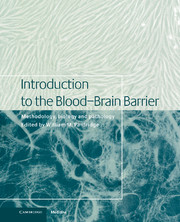Book contents
- Frontmatter
- Contents
- List of contributors
- 1 Blood–brain barrier methodology and biology
- Part I Methodology
- 2 The carotid artery single injection technique
- 3 Development of Brain Efflux Index (BEI) method and its application to the blood–brain barrier efflux transport study
- 4 In situ brain perfusion
- 5 Intravenous injection/pharmacokinetics
- 6 Isolated brain capillaries: an in vitro model of blood–brain barrier research
- 7 Isolation and behavior of plasma membrane vesicles made from cerebral capillary endothelial cells
- 8 Patch clamp techniques with isolated brain microvessel membranes
- 9 Tissue culture of brain endothelial cells – induction of blood–brain barrier properties by brain factors
- 10 Brain microvessel endothelial cell culture systems
- 11 Intracerebral microdialysis
- 12 Blood–brain barrier permeability measured with histochemistry
- 13 Measuring cerebral capillary permeability–surface area products by quantitative autoradiography
- 14 Measurement of blood–brain barrier in humans using indicator diffusion
- 15 Measurement of blood–brain permeability in humans with positron emission tomography
- 16 Magnetic resonance imaging of blood–brain barrier permeability
- 17 Molecular biology of brain capillaries
- Part II Transport biology
- Part III General aspects of CNS transport
- Part IV Signal transduction/biochemical aspects
- Part V Pathophysiology in disease states
- Index
12 - Blood–brain barrier permeability measured with histochemistry
from Part I - Methodology
Published online by Cambridge University Press: 10 December 2009
- Frontmatter
- Contents
- List of contributors
- 1 Blood–brain barrier methodology and biology
- Part I Methodology
- 2 The carotid artery single injection technique
- 3 Development of Brain Efflux Index (BEI) method and its application to the blood–brain barrier efflux transport study
- 4 In situ brain perfusion
- 5 Intravenous injection/pharmacokinetics
- 6 Isolated brain capillaries: an in vitro model of blood–brain barrier research
- 7 Isolation and behavior of plasma membrane vesicles made from cerebral capillary endothelial cells
- 8 Patch clamp techniques with isolated brain microvessel membranes
- 9 Tissue culture of brain endothelial cells – induction of blood–brain barrier properties by brain factors
- 10 Brain microvessel endothelial cell culture systems
- 11 Intracerebral microdialysis
- 12 Blood–brain barrier permeability measured with histochemistry
- 13 Measuring cerebral capillary permeability–surface area products by quantitative autoradiography
- 14 Measurement of blood–brain barrier in humans using indicator diffusion
- 15 Measurement of blood–brain permeability in humans with positron emission tomography
- 16 Magnetic resonance imaging of blood–brain barrier permeability
- 17 Molecular biology of brain capillaries
- Part II Transport biology
- Part III General aspects of CNS transport
- Part IV Signal transduction/biochemical aspects
- Part V Pathophysiology in disease states
- Index
Summary
Introduction
The advent of electron microscopy and the availability of horseradish peroxidase (HRP) as a marker to study vascular permeability to proteins (Graham and Karnovsky, 1966), opened a new era in the study of the blood–brain barrier (BBB). Over the next two decades there was a plethora of studies of BBB permeability to HRP in steady states and in diverse pathological conditions. Horseradish peroxidase, a glycoprotein with a molecular weight of 40 000, can be localized in tissues by both light and electron microscopy. Both the tracer and the HRP reaction product which forms in tissues following a histochemical reaction will be referred to as HRP.
Blood–brain barrier permeability to HRP in steady states
The morphological features unique to cerebral vessels, in contrast to other body vessels, that account for their relative impermeability to plasma proteins and protein tracers such as HRP in steady states, are limited endothelial pinocytosis and the presence of tight junctions along the interendothelial spaces. Other factors affecting BBB permeability to HRP are endothelial surface charge and endothelial cytoskeletal elements.
Pinocytosis
Fluid-phase transcytosis of HRP across endothelium occurs by pinocytotic vesicles, which are membrane-bound spheres, 50–90 nm in diameter. The classic study of Reese and Karnovsky (1967) drew attention to the finding that during steady states, cerebral endothelium contains few pinocytotic vesicles.
- Type
- Chapter
- Information
- Introduction to the Blood-Brain BarrierMethodology, Biology and Pathology, pp. 113 - 121Publisher: Cambridge University PressPrint publication year: 1998
- 5
- Cited by

